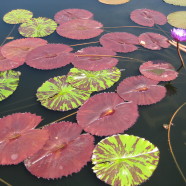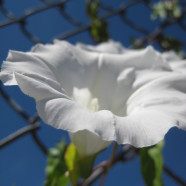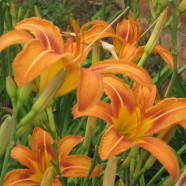Cattails: Winter Warmth
Cattails in a winter marsh, with a skim of ice on the water. This chilly picture seems to be the very essence of cold. But actually this is an image of potential warmth. You’ve seen cattail seed heads, I’m sure, when they’re just ripe–they look like a brown velvet hot dog impaled on a stick. Just one of those spikes can hold an unbelievable number of seeds–somewhere in the vicinity of a quarter of a million seeds on each stalk. Each individual seed is a tiny dot, almost invisible, attached to a little cluster of fluff, which acts as a parachute so the seeds can...
Read MoreLily Pad Lifestyle
Floating along without a care in the world. Such effortless beauty. No wonder Monet couldn’t stop painting them. At the New York Botanical Garden, my favorite place is the the water lily pool. Its giant surface is covered with lily pads and fringed by tall lotus blossoms with leaves the size of bicycle tires. Reflections of the sky and the white conservatory buildings mingle with the lilies and the lotuses–it’s sort of a cross between between Paris and the Nile. The thing about a shallow, still pool like this is that you can’t see all the way to the bottom. Water lilies,...
Read MoreChocolate in Bloom
Yes! The chocolate is in bloom! Now on view at the New York Botanical Garden in the Bronx, NY. What I can’t figure out is how anyone ever discovered the insanely fabulous taste of this plant. It’s a very easy plant to ignore. It blends in with the other trees in the tropical section of the Botanical Garden’s enormous conservatory. The little cacao tree is dwarfed by palm trees and giant ferns, totally upstaged by orchids and bird-of-paradise flowers. The leaves are nondescript, the flowers pretty but half an inch long. But come and worship at the foot of this homely little...
Read MoreMorning Glory: The Vine Lifestyle
There’s something shady about vines. Look at the names we give them—creepers, stranglers, parasites. I guess, in our puritan work ethic, there’s something morally dubious about a plant that can’t stand on its own two feet, so to speak. Why can’t vines get out and support themselves and not go draping themselves all over things? To call someone a “clinging vine” is to imply weakness. But actually vines are among the most powerful and successful plants on the planet. They succeed in ways more upright, self-supporting types can’t. Vines can exploit habitats that no other type of plant could...
Read MorePoison Ivy: Jumping to Conclusions
Quick! Is this plant poison ivy? Now I’m afraid I get testy when I hear people pointing out perfectly harmless plants as poison ivy–I’ve heard people swear that a maple tree (with reddish leaves) or a raspberry bush or a geranium was a deadly plant to avoid. I’m convinced that one of the many reasons kids are so reluctant to go outdoors is that they think everything with a leaf is poison ivy. In this case, though, I can’t get all snitty because it fooled me, too. I would have to humbly pardon the person who called this plant poison ivy. It’s the best darn imitation I’ve ever...
Read MoreDay Lily: Summer Schedule
Day lily. Hemerocallis, which comes from ancient Greek words meaning beautiful day. Day lilies are suddenly all over the place in early July. They start to line the roadsides as though waiting for the Fourth of July parades. The orange bursts of petals among the green are a kind of botanical fireworks. Why the name day lily? If you look on any day lily stalk, you’ll see half-a-dozen buds, each one slightly bigger than the next. With a punctuality that’s pretty amazing, they will open precisely 24 hours apart. So that on one stalk you have, so to speak, the entire schedule for the week. Today...
Read More










Recent Comments